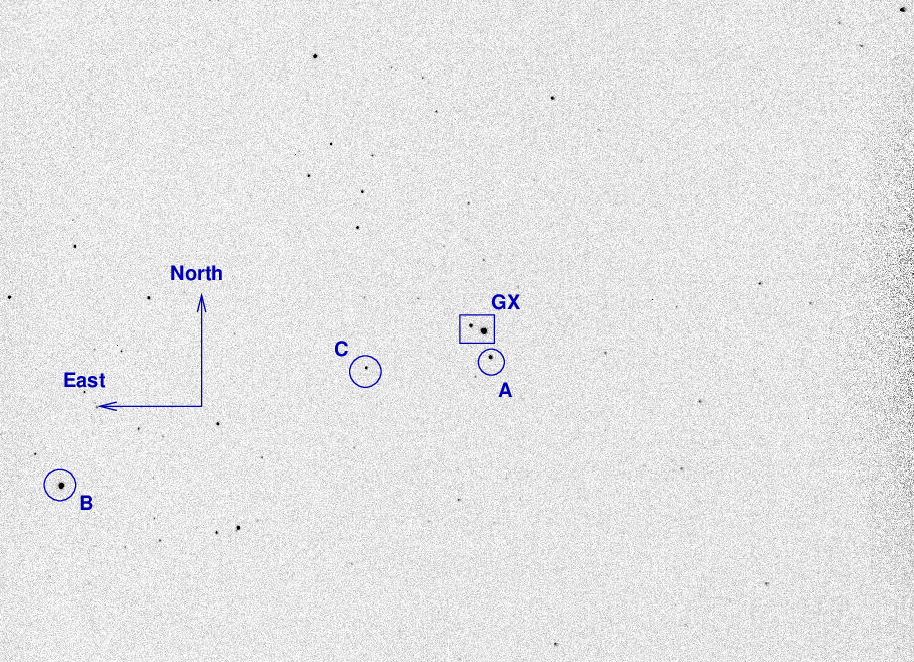
On the night of Aug 24/25, 2021, under fair conditions, I acquired images of the intermediate polar 1RXS J213344.1+510725 for the first time. This is one of seven variable stars for which the AAVSO has requested measurements:
The nearly full Moon, plus quite a bit of haze, made the sky bright, but I was able to establish that the target was in its ordinary bright state (not, alas, the faint state that is more interesting).
I also acquired astrometry of Ross 248 and GX And as part of a long-term project to measure their parallaxes.
Ava Covington and Aaran Shaw have asked AAVSO observers to monitor a set of seven intermediate polars over the next year. One of them, 1RXS J213344.1+510725, was well-placed for observations now, so I decided to give it a shot. It's pretty faint for our instrument.
The main setup was:
Notes from the night:
The object is located at
RA = 21:33:43.63 Dec = +51:07:24.7 (J2000)
A chart of the field is shown below.

I've marked the location of several comparison stars as well. See
I'll use star "D" to shift my instrumental magnitudes to the V-band scale. It has a V-band magnitude (according to AAVSO chart X26828ZG) of 13.461, and (B-V) = 0.892.
I took a photo of the finder TV's screen when pointing to this target; this could be a useful reference for the future:

The sky value shows increasing brightness, due to clouds and Moon, for most of the night.

The FWHM graph below shows virtually no drift throughout the night. Nice.

Using aperture photometry with a radius of 7 pixels in a V filter (binned 2x2, each pixel is 1.24 arcsec, so a radius of 8.7 arcsec), I measured the instrumental magnitudes of a number of reference stars and the target. Following the procedures outlined by Kent Honeycutt's article on inhomogeneous ensemble photometry, I used all stars available in each image to define a reference frame, and measured each star against this frame.
Sigma-vs-mag plots show that the floor was about 0.005 mag after I removed a few images with large outliers.

The change in zeropoint shows a pattern that mirrors that of the sky value: clouds early, diminishing late.

Here is the light curve of the object and several field stars in the V filter; I've shifted the instrumental magnitudes so that star "D" = 000-BJX-010 on AAVSO chart X26828ZG has the value given by AAVSO as its V-band magnitude.

I have submitted these measurements to the AAVSO.
You can download my measurements below. A copy of the header of the file is shown to explain the format.
# Measurements of 1RSXJ213344.1+510725 made at RIT Obs, UT 2021 Aug 25, # in fair conditions (bright Moon, haze), # by Michael Richmond, # using Meade 12-inch LX200 and ATIK 11000. # Exposures 60 seconds long, clear filter. # Tabulated times are midexposure (FITS header time - half exposure length) # and accurate only to +/- 1 second (??). # 'mag' is a differential magnitude based on ensemble photometry # using a circular aperture of radius 7 pix = 8.8 arcseconds. # which has been shifted so AAVSO 000-BJX-010 has mag=13.461 # which is its V-band magnitude according to AAVSO chart X26828ZG. # # UT_day JD HJD mag uncert Aug25.08852 2459451.58852 2459451.59121 15.402 0.071 Aug25.08936 2459451.58936 2459451.59205 15.429 0.074
This is one of the stars that a capstone student may study over the next year in a project involving parallax. Ross 248 is a relatively faint red star surrounded by many other stars of similar brightness, so it's a good candidate for high-precision parallax measurements.
These observations involved:
The object is (currently) near position
RA = 23:41:55.27 Dec = +44:10:06.38 (J2000)
A chart of the field is shown below. The size of the chart is about 41 x 27 arcminutes. The noisy area at right (West) is the shadow of the guider's pickoff mirror.

I've marked the location of several comparison stars.
star UCAC4 B V r ------------------------------------------------------------------------- A UCAC4 671-120730 12.617 10.689 B UCAC4 671-120688 C UCAC4 671-120749 10.987 10.663 P kappa And 4.06 4.14 --------------------------------------------------------------------------
I took a photo of the finder TV's screen when pointing to Ross 248; this could be a useful reference for the future:

Here are the positions I've measured so far. The most recent measurements are at bottom right.

Like Ross 248, GX And is a nearby (binary) star which will be the target of a parallax project in the coming year. One of the two components is bright -- about mag V = 8 -- so one must use short exposures to prevent it from saturating the detector. That may mean that this system isn't as easy to measure as Ross 248 or some others.
The object is currently close to this position:
RA = 00:18:28.4 Dec = +44:01:31 (J2000)
but it does have a very high proper motion.
A chart of the field is shown below. The size of the chart is about 41 x 27 arcminutes. The noisy area at right (West) is the shadow of the guider's pickoff mirror.

The two components of the GX And binary sit inside the box. I've marked the location of several comparison stars as well.
star UCAC4 B V r ----------------------------------------------------------- A 671-001473 9.939 9.790 B 670-001639 9.413 8.472 C 671-001509 12.712 11.421 11.001 -----------------------------------------------------------
I took a photo of the finder TV's screen when pointing to GX And; this could be a useful reference for the future:

Using the same techniques as described for earlier nights, I matched detected stellar positions to the Gaia DR2 catalog.
The target is moving to the upper-right with time, and clearly shows the back-and-forth motion due to parallax.

Last modified 8/27/2021 by MWR.